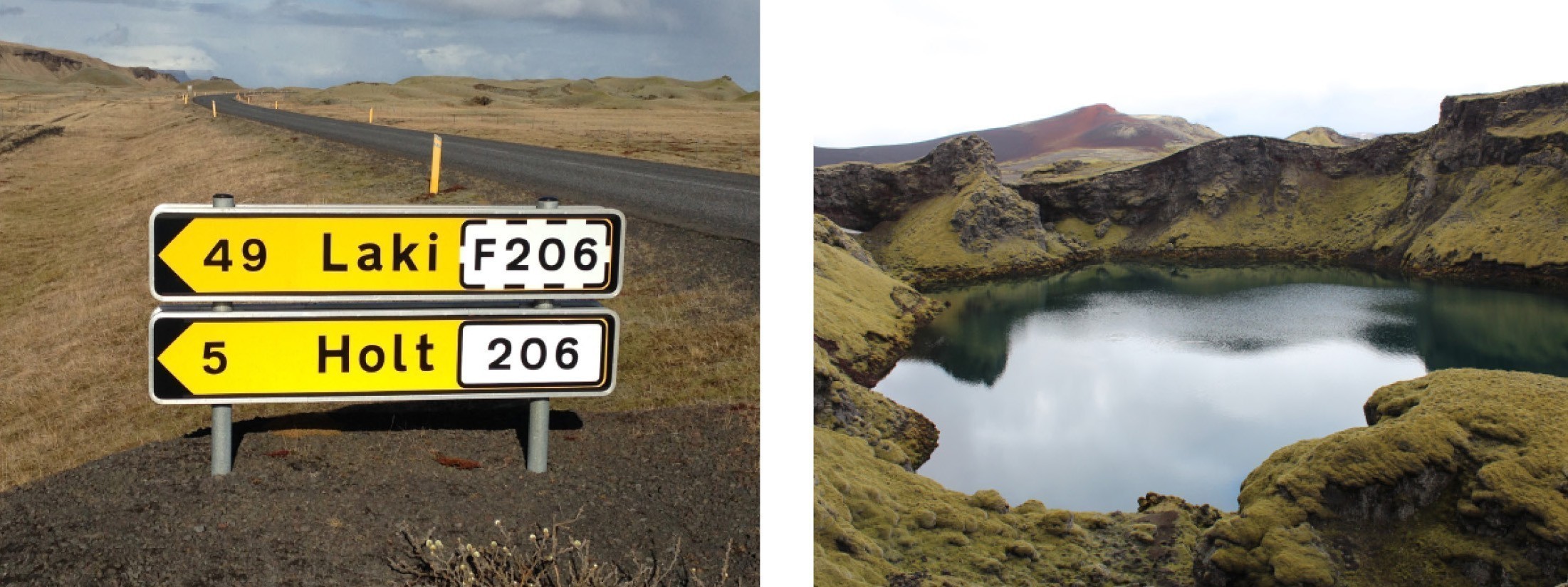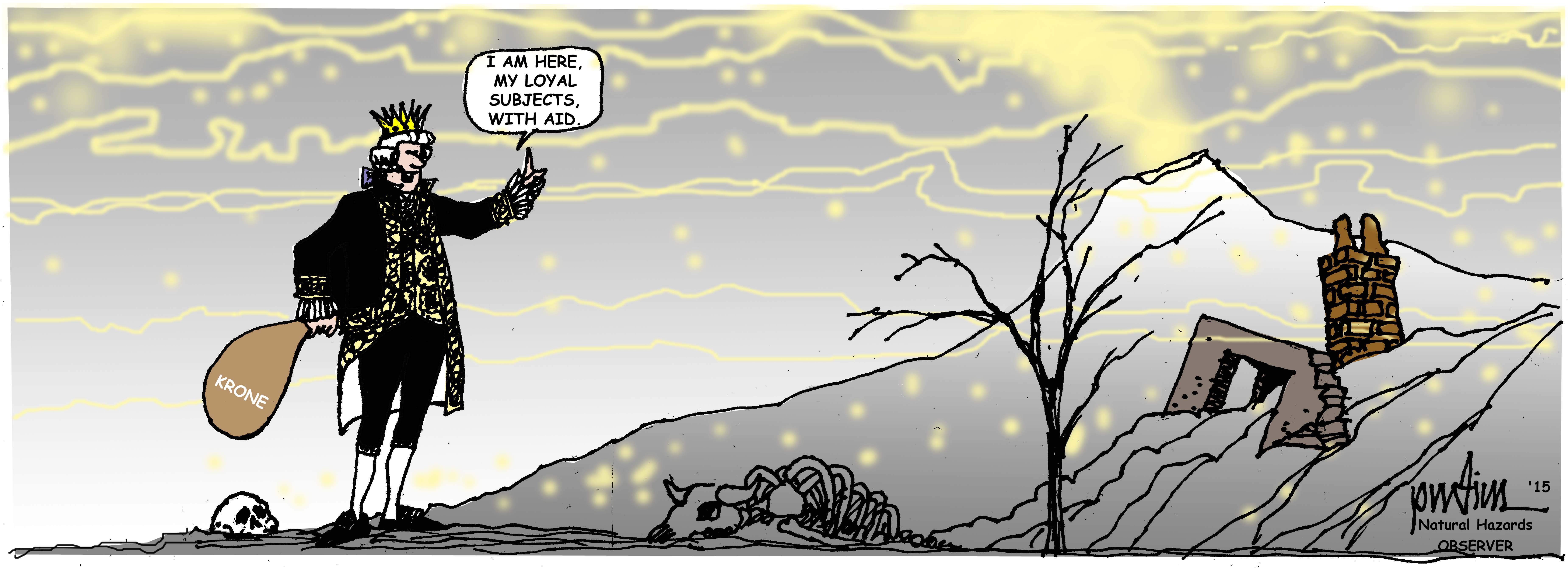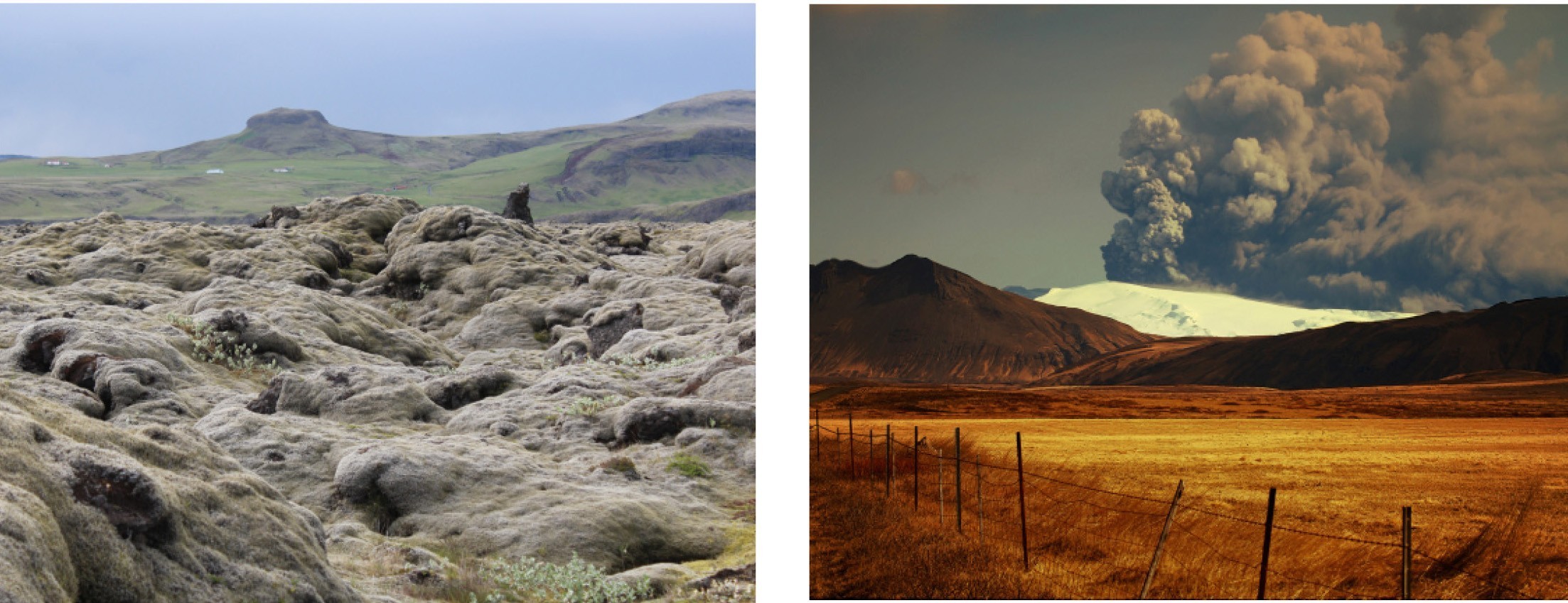By Alexandra Witze

Laki © Alexandra Witze
On the morning of June 8, 1783, the ground ripped open in south-central Iceland and began spewing fire. This violent volcanic outburst, known as the Laki eruption, lasted eight months. Its effects lingered for years, not just in Iceland but around the globe. From poisoning the skies over Europe to changing climate across the Northern Hemisphere, the Laki eruption was one of the most extraordinary volcanic events in history.
The eruption shaped the modern scientific understanding of Icelandic volcanoes and the power they unleash. Lessons from this 18th century calamity have helped researchers understand and respond to other disasters in the past few years, including the economically devastating 2010 eruption of the Eyjafjallajökull volcano that grounded planes across Europe. The Laki eruption provides a historical springboard for exploring Icelanders’ resiliency to volcanic disasters—and how other volcanically active areas can learn from this small island nation.
Laki
It all began in Iceland’s wild highlands, a couple of hours drive east of what is now Reykjavik. In 1783, the area around Laki was home to rural farming communities that depended on sheep that grazed the lush pasturelands and fish that danced through the cold clear streams. The eruption ended all that. One bright morning, a dark cloud appeared to the north, rising higher and soon blotting out the sky. Within hours, a blizzard of ash fell over towns and mixed with rainwater to form a dark, unavoidable slurry (Witze and Kanipe, 2015).
Lava followed. Huge rivers of molten rock flowed down from the highlands, swallowing farm after farm in their fiery path. During the first 12 days, the Laki eruption put out the equivalent of two Olympic-sized swimming pools of lava every second. By the time it was all over, in February 1784, it could have buried Manhattan 820 feet deep in newly formed rock.
The eruption devastated Iceland. Ashfall buried the summer grass so that sheep, cattle, and horses starved. Throughout the winter of 1783-84, and for several years to follow, families had almost nothing to eat. Over the next two years the famine that set in, known as the “mist hardships” for the volcanic fog that enshrouded the land, killed nearly 10,000 Icelanders from starvation—one fifth of the island’s population at the time (Jackson, 1982).
What happened in Iceland did not stay in Iceland. The Laki eruption belched out huge amounts of gases—including more than 120 million tons of sulfur dioxide—that became caught up in southeast-flowing winds and carried toward Europe. Throughout the summer of 1783, a peculiar “dry fog” was seen in London, Paris, Stockholm, Rome, and beyond. People reported a sour smell in the air, trouble breathing, and plants withering on exposure. In essence, the sulfur dioxide had transformed into an acidic fog that spread across the continent (Thordarson and Self, 2003).
In one final insult, the volcanic particles also acted as a giant sunscreen, reflecting the sun’s energy back into space. Temperatures plummeted and the winter of 1783-84 was one of the coldest on record for much of the Northern Hemisphere. Climate was disrupted for years afterward across the Northern Hemisphere. In Egypt, the flow of the Nile River dropped, cutting off irrigation waters and leading to widespread famine. By the time it was over, the direct and indirect effects of the Laki eruption are estimated to have killed more than one million people worldwide.

Within Iceland, it remains the most societally devastating eruption since Vikings settled the island around the year 871 A.D. The Laki disaster is imprinted in the national psyche as a kind of worst-case scenario for what natural disasters can do. It took many years for residents to rebuild their lives and the economy to slowly recover.
One of the biggest challenges in responding to the Laki eruption was Iceland’s isolation and poverty at the time. The island was ruled by the king in far-off Copenhagen. When word of the disaster finally reached Denmark, carried by sailors who passed through Iceland’s rich fishing grounds, the king dispatched emergency relief funds—but there was simply no infrastructure for ensuring that money and supplies got into the hands the farmers whose livestock and lands had been destroyed.
Eyjafjallajökull
Since Laki there have been plenty of other eruptions in Iceland. The island has at least 30 active volcanoes, with an eruption once every five years on average (Thordarson and Larsen, 2007). But the 1783-84 Laki eruption is the benchmark by which all others are measured, thanks to its devastating impact on the country. Laki put out more lava and more gases than any other eruption in Iceland’s history, except for a 10th century event that occurred before the country was widely settled. Modern volcanologists have mapped the sprawling Laki lava flows and can now use that data to calculate how much molten rock and gas a single Icelandic eruption can put out at a time.
Over the past two centuries, Icelanders have internalized the lessons of Laki and worked to understand and prepare for future eruptions. Today, despite a 2008 near financial collapse, Iceland is one of the most technologically advanced nations in the world. Its volcanoes are extremely well monitored and its civil-protection service responds almost immediately to any impending eruption. Unlike in 1783, people can sit at home and check the Icelandic Meteorological Office website for the latest news, maps, and predictions of what natural disaster might happen next.
That came in handy in the spring of 2010, when the now-infamous volcano known as Eyjafjallajökull erupted. Within Iceland, the impacts were fairly mild. No one died in the eruption, and the most serious repercussions were for farmers whose fields and livestock were covered in ash. Still, it offered a chance for Icelanders to update their emergency preparedness.
Eyjafjallajökull wasn’t a particularly large eruption by Icelandic standards, but it had an outsized effect on the rest of Europe (Karlsdóttir et al., 2012). Just as with the Laki eruption in 1783, the prevailing winds blew south and east—directly toward European airspace. Aviation officials made the drastic decision to ground nearly all commercial flights, including those at vital transportation hubs such as London’s Heathrow airport. They did so because volcanic ash can melt and fuse into a glasslike substance inside jet engines, shutting them down.
The affair underscored just how poorly prepared Europe was for an Icelandic eruption. At the time, aviation guidelines for how much volcanic ash a plane could fly through were vague and outdated, which led officials to err on the side of safety and ground more planes than were perhaps necessary. With paying passengers grounded and cargo unable to move across Europe, total economic losses soared into the billions of euros.
Eyjafjallajökull was a wake-up call for European officials. Among other changes, it prompted the UK government to add Icelandic volcanoes to its National Risk Register, an official list of the dangers that emergency officials should prepare for. (The register explicitly cites the 1783-84 Laki disaster as the best-understood example of a big eruption to be planned for, including the possibility of high levels of polluting gases wafting across Europe for months.) The International Civil Aviation Organization (ICAO) also relaxed its guidelines for the acceptable concentrations of ash that planes can fly through, effectively putting more power in the hands of airlines and pilots to make their own decisions in volcanic ash emergencies.

(L) Laki © Alexandra Witze (R) Eyjafjallajökull © Sverrir Thorolfsson
Grímsvötn
Lessons from Eyjafjallajökull were put to the test the very next year. In April 2011, the ICAO coordinated an exercise in which more than 70 airlines and emergency responders practiced how they would respond to an eruption of Iceland’s most active volcano, Grímsvötn. As if on cue, Grímsvötn erupted the following month. This time, the weather patterns did not blow as much ash into European airspace, but Europe was also much better prepared. Officials sprang into action, immediately assessing the amount of ash and how much of a threat it posed to aviation. Coordination among groups was smoother and information flowed more quickly. In the end, the Grímsvötn eruption—which was physically more powerful than Eyjafjallajökull the previous year—caused far less transportation havoc (Parker, 2014).
Bárdarbunga
And then came a different kind of test. In August 2014, yet another Icelandic volcano erupted—not in an ash-rich blast like Eyjafjallajökull or Grímsvötn, but in a gas-rich eruption like Laki. In the country’s northeast, in a remote area known as Bárdarbunga, a fissure ripped open and began spouting lava. It looked remarkably like a miniature version of Laki, one-tenth its size.
Just as happened in 1783, Icelanders found themselves in the middle of an atmospheric pollution emergency. For more than three months, the eruption belched some 35,000 tons of sulfur dioxide a day, nearly three times the annual anthropogenic emissions of the European Union (Gettelman et al., 2015). Shifting winds carried the gassy plume in different directions across the island, where automated atmospheric monitoring stations measured sulfur dioxide levels. At times they spiked well above acceptable World Health Organization levels of exposure. Television forecasts included information about what parts of the country should expect the plume of polluted air over the next few days. When gas concentrations were particularly high, children and the elderly were warned to stay inside.
The Bárdarbunga eruption petered out in February 2015. Fortunately, it didn’t emit enough sulfur dioxide high enough into the atmosphere to be transported across to Europe and change the global climate as the Laki eruption did. But it did provide a test case for how emergency officials would respond in the event of a gas-rich eruption on the scale of Laki.
One estimate suggests that if a Laki-scale eruption were to happen tomorrow, 142,000 people across Europe would die from the gas exposure
Among other shortcomings, Bárdarbunga made clear that scientists need to improve predictions of how gas might spread—and what health effects it might have—in a way that local residents can use. In the wake of the 2010 Eyjafjallajökull emergency, officials forgot somewhat about the lessons of Laki and spent more time thinking about and preparing for the possibility of an ash-rich, not a gas-rich, eruption. Iceland was lucky that Bárdarbunga was a small eruption. One estimate suggests that if a Laki-scale eruption were to happen tomorrow, 142,000 people across Europe would die from the gas exposure (Schmidt et al., 2011).
New Initiatives
Perhaps the biggest lesson from the recent Icelandic eruptions is a growing awareness of the many types of volcanic hazards contained in just one small country. As a scientifically advanced and technologically connected nation, Iceland is leading the way in understanding and predicting such eruptions. One major new initiative put in place after Eyjafjallajökull is a European Union-funded project called FUTUREVOLC. It has beefed up the networks of seismometers and global-positioning-system instruments around several of Iceland’s most active volcanoes so that volcanologists have advance warning when the ground begins to shift. Such movements can be signs of magma flowing within the earth on its way toward a full-fledged eruption.
FUTUREVOLC scientists work closely with researchers at other dangerous volcanoes, such as Italy’s Vesuvius and Etna. They hope that what they learn in Iceland will translate to other locales, allowing everyone to better predict when evacuations are needed. The ultimate goal is to share that experience worldwide, at active volcanoes in in areas such as the Caribbean, Indonesia, and beyond.
As the Bárdarbunga eruption made clear, there is still a long way to go. Even a well-prepared nation like Iceland can be caught unaware by the unexpected violence or nature of a new volcanic eruption. But each eruption—whether Laki in 1783, Eyjafjallajökull in 2010, or Bárdarbunga in 2014—adds another piece of scientific and societal understanding to the puzzle.
REFERENCES
Gettelman, A. et al. 2015. “Icelandic volcanic emissions and climate” Nature Geoscience, 8, 243. Jackson, E.L. 1982. “The Laki eruption of 1783: impacts on population and settlement in Iceland” Geography, 67, 42-50.
Karlsdóttir, S. et al. 2012. The 2010 Eyjafjallajökull eruption, Iceland. Report to the International Civil Aviation Organization, June 2012. http://en.vedur.is/media/ICAOreport_web_lr.pdf (accessed on September 11, 2015).
Parker, C. F. 2014. “Complex negative events and the diffusion of crisis: lessons from the 2010 and 2011 Icelandic volcanic ash cloud events” Geografiska Annaler: Series A, Physical Geography, 97, 97-108.
Schmidt, A. et al. 2011. “Excess mortality in Europe following a future Laki-style Icelandic eruption”. Proceedings of the National Academy of Sciences, 108 (38), 15710-15715.
Thordarson, T. and Larsen, G. 2007. “Volcanism in Iceland in historical time: volcano types, eruption styles and eruptive history” Journal of Geodynamics, 43, 118-152.
Thordarson, T. and Self, S. 2003. “Atmospheric and environmental effects of the 1783-1784 Laki eruption: a review and reassessment” Journal of Geophysical Research, 108 (D1), 4011.
Witze, A. and Kanipe, J. 2015. Island on Fire: The Extraordinary Story of a Forgotten Volcano That Changed the World. New York: Pegasus Books.
